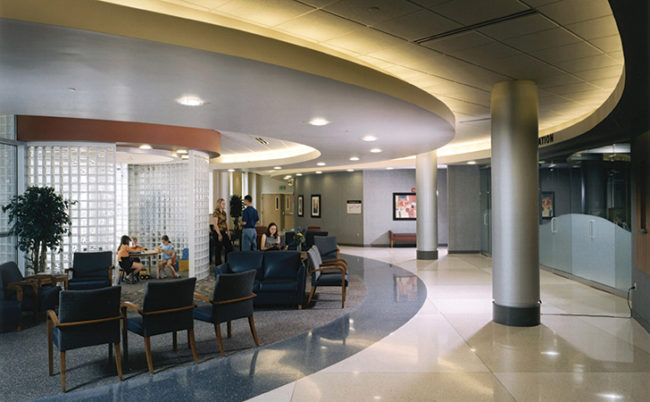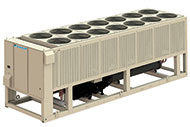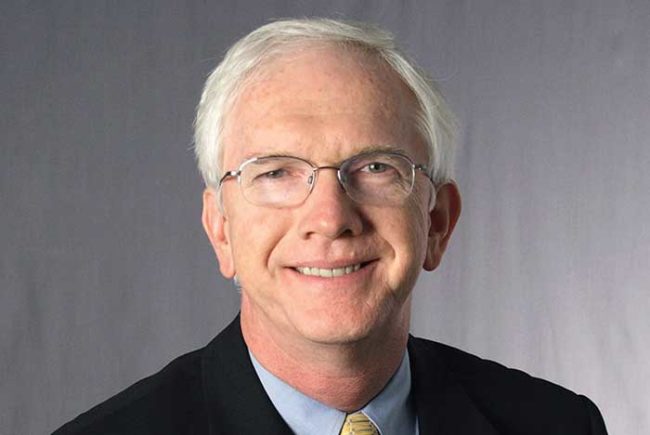
View "Building for boomers" Gallery
This year, the last of the baby boomers turn 50. The oldest are on the cusp of 70. As people born between 1946 and 1964 are getting older and becoming a predominant health care demographic, facility designs are responding to their needs and expectations.
“The baby boom generation is so significantly larger than the generations immediately before and after it that, basically, what the boomer wants, the boomer gets,” says Joe Flower, health care speaker, writer and consultant. Flower, co-author of Age Wave (Bantam, 1990) with Ken Dychtwald, has been studying the future of health care and the effects of the aging baby boomer cohort for years. “If something is of concern to boomers, it becomes a concern nationally,” he says.
By their sheer numbers, baby boomers have been influencing the marketplace since their Gerber days, says health care interior designer Rosalyn Cama, FASID, EDAC, board chair of the Center for Health Design, Concord, Calif., and president, Cama Inc., New Haven, Conn. The health care market is no exception.
Having it their way
“For years the health care market has been concerned about this huge bulge of baby boomers: As they enter the age in which they become heavy users of the health care system, how is the system going to react?” asks health care architect Sandy Faurot, AIA, ACHA, vice president, RTKL’s Chicago office. “It’s not just the numbers, it is the characteristics” of a generation regarded as knowledgeable, outspoken and assertive, that raise the question, he says.
Known as the “me generation,” baby boomers “are used to having their way and speaking up,” says health care interior designer Jain Malkin, CID, AAHID, EDAC, founder, Jain Malkin Inc., San Diego. Baby boomers also tend to be responsible and self-reliant, and expect a lot from other people in turn, adds Amy Sickeler, RID, LEED AP, interior design principal, health care interiors practice leader and director of design for the interiors department at architecture firm Perkins+Will’s Atlanta office. As they age, baby boomers “are going to expect a lot from facilities,” she says.
Evelyn Reyers, AIA, LEED AP, Lean Six Sigma CE, EDAC, associate principal and senior vice president in the Dallas office of architecture firm HKS, says aging baby boomers want different things in hospitals and care homes than those of previous generations. “They are looking for more involvement in their care and decision-making, and want more choices that support a more active and mobile lifestyle, which does not fit the standard definition of ‘old,’ ” she says.
“Our parents didn’t expect a lot [from health facilities,]” says Sickeler. But baby boomers think, “‘I’m not going to go to a depressing place. I’m going to go to an exciting place,’ ” she adds. Providers need to respond with high-quality, patient-focused design, not mere window dressing. “It’s not okay to just put a beauty shop in an old janitor closet. People want more seamless coverage of care. They demand support and to be thought of as human beings.”
Sophisticated consumers
For a health care organization, “the building is really just a vessel for an operating model. It needs to react to the model of delivering care,” says Faurot. Facilities with hospitality design features like fine finishes and retail and dining opportunities demonstrate a patient-centered care model. Faurot says this appeals to baby boomers, who he describes as sophisticated consumers who expect a pleasant experience in the health care environment as well as a positive outcome. “Of course, evidence has shown that that kind of experience leads to better outcomes,” he says, noting the proven benefits of quieter, less stressful environments with better views. “If it feels better, it heals better.”
Cadence Health, Winfield, Ill., which merged in September with Northwestern Memorial HealthCare, Chicago, addressed this idea in the design of a new bed pavilion at Central DuPage Hospital (CDH), Winfield, and the CDH Cancer Center, Warrenville, Ill. According to Faurot, every detail of these buildings’ designs — down to the carpet installed to reduce noise on patient units — was chosen to support the health system’s operational model, which is inspired by the quality experience of five-star hotels. Design details include attractive landscaping; entry sequences meant to be gracious, welcoming and easy to understand; multiple dining and gift shop options; a variety of well-appointed guest lounges and waiting areas; and an overall ambience of spalike comfort.
Brigham and Women’s Hospital, Boston, is in the midst of multiple design initiatives, including architecture, landscaping, graphics and signage, to improve the patient experience. The national HCAHPS survey gives patients an instrument to evaluate their experience with a hospital’s physical environment and level of care, making it especially important for facilities to help providers deliver on both fronts. “I think a combination of the Affordable Care Act’s pushing the consumer evaluation and a population that is a bit self-centered and quite informed will start to put more demands on this experiential piece,” says Cama, who is participating in the Brigham and Women’s project. “If hospitals aren’t thinking about it, they should be.”
Roberta Luskin-Hawk, M.D., regional president and CEO, Presence Saint Joseph Hospital, Chicago, and Presence Saint Francis Hospital, Evanston, Ill., says, “There’s a new consumerism in health care. People are looking for ease of access [and] a wonderful experience.” For baby boomers, this is represented by well-designed facilities, high-quality care and good value. Flower points out that baby boomers were hit especially hard by the recent economic downturn, because people age 55–65 have had little time at the end of their careers to recoup lost home equity and retirement savings. Financial considerations, including Medicare co-pays, cause baby boomers to be careful shoppers when it comes to health care, he says. Sickeler cautions health providers: “There will be a backlash to a hotel look if the service doesn’t match.”
Educated, tech savvy
Baby boomers tend to be educated, tech-savvy individuals. “[They are] aware of the impact of technology in health care,” says Faurot. Advanced medical technology, as well as information technology tools like digital patient education and entertainment systems and registration kiosks, are appealing to this group. Their comfort with technology facilitates the use of home-health monitoring devices and virtual visits. According to Faurot, facility designs can help to accommodate telemedicine services by including sufficient back-of-the-house spaces with the appropriate lighting and backdrop for videoconferencing.
The Presence Center for Advanced Care (PCAC) at Presence Saint Joseph Hospital, scheduled to open next fall, is being designed to incorporate several levels of medical and personal technology. The center will feature medical equipment ranging from X-ray machines to a linear accelerator, electronic health records, Wi-Fi throughout the building and a distributed antenna to reinforce cellular phone signals. Videoconferencing capabilities will enable physicians to engage in remote consultations. And an online patient portal will allow patients to access health information and communicate with physicians after leaving the facility.
Unlike 20-year-olds, who are often content to go to their local retail pharmacy to receive medical care, baby boomers value a relationship with their physicians, says Luskin-Hawk. “They are looking for a personal touch,” notes Faurot. This is often expressed through a related interest in wellness and holistic care and an appreciation for sustainable design principles.
In addition to its high-tech features, the PCAC will feature a bamboo garden, green roof and views of Lake Michigan. The project team is targeting a LEED Silver designation for the building, which Presence Health is touting as “a new health and wellness destination.” According to Luskin-Hawk, “the focus of the PCAC is to provide high-level ambulatory care that, if done right, actually will help keep people healthier and out of the hospital.” For example, an education and wellness center will provide counseling on diet and diabetes management. A center for integrative medicine is also among the many services planned to be offered at the facility.
The Duke Medicine Pavilion, Durham, N.C., was built in a prime location on the campus of the Duke University Medical Center. Sickeler describes the medical campus as “a formal, tailored, serious environment.” She says that for the pavilion, the designers strove to honor the university’s atmosphere and existing neo-Gothic architecture while creating a humane setting for patient care. Elevated courtyards and gardens, floor-to-ceiling glass in patient rooms and central light wells on patient units maximize access to natural light and views throughout the building. The LEED Gold project received a 2013 Landscape Architecture Award for Healthcare Environments in the acute care category from the Center for Health Design and the Society for the Advancement of Gerontological Environments.
“I think dealing with the baby boom generation was implicit in what we did to make an environment that was more relaxing, more homelike, more inviting than you typically would see in an institution,” says Gregory Warwick, AIA, Duke University Medical Center architect. He says the pavilion, designed by Perkins+Will, and the hospital’s new cancer center, designed by Tsoi/Kobus & Associates, Cambridge, Mass., share a consistent look, with features like softer, more restful waiting areas, intended to impart a sense of comfort and dignity to patients and their families.
Demanding more
Malkin notes that although baby boomers generally are considered en masse, like any large group of people, they are not homogeneous. “There are profound differences in experience between the early boomers and the late boomers,” she says. “Boomers encompass the educated and the illiterate, the fit and the obese, workers and retirees, active seniors and frail elderly. They interact with the health system as patients and as caregivers. Even considering the needs of one generation, you have to design for all types of people.”
But, as a group, baby boomers have controlled the national conversation throughout their lives as they passed the milestones of childhood, young adulthood, parenting and middle age. AARP, the membership organization for people 50 and older, notes that “as this unique cohort grows older, it likely will transform the institutions of aging — just as it has done to other aspects of American life.” Health care design is not immune to this influence. As we demand more, our great facilities will do more, Sickeler says.
By turning attention toward designs that can improve health care experiences and outcomes for patients of all ages, baby boomers are inspiring a new generation of health facilities. HFM
is a freelance writer based in Homewood, Ill., who specializes in health care-related topics. She is a regular contributor to Health Facilities Management.
Addressing the effects of aging
Baby boomers have a reputation for youthfulness, but as the youngest members of this generation pass the half-century mark, they are dealing with the effects of age. Facility designs are, too.
“Aging bodies don’t care if you’re a baby boomer or not,” says health care interior designer Jain Malkin, CID, AAHID, EDAC, founder, Jain Malkin Inc., San Diego. Issues with cognitive ability, vision, hearing, speech intelligibility and mobility can make health facilities difficult for older people to navigate. These difficulties can be addressed in design, Malkin says.
For people with memory issues, wayfinding can be especially challenging, so clear circulation routes are helpful. At Silver Cross Hospital, New Lenox, Ill., the emergency department, hospital lobby, café, outpatient center, medical office building and cancer center are aligned down a single corridor on the building’s main floor. This straightforward path is reinforced by signage and features several seating areas along the way. Master planning for the facility will allow for the construction of additional patient floors or a new bed tower without disrupting the wayfinding scheme.
Evelyn Reyers, AIA, LEED AP, Lean Six Sigma CE, EDAC, associate principal and senior vice president in the Dallas office of architecture firm HKS, says thoughtful interiors can improve facilities for people with physical limitations. Furniture selections that include bariatric options, a variety of heights in seats and seatbacks, and chairs with arms are useful to people with mobility problems. This is also a consideration for toilet heights, says Reyers. Flooring with appropriate slip coefficiency and low or no glare can help to reduce falls, as can placing nurse charting and touchdown locations in close proximity to patient beds, she adds. Appropriate lighting and acoustics can help to alleviate issues with sight and hearing, and reduce errors by caregivers.
Reyers notes that some facilities have added senior emergency departments (EDs) and Acute Care for the Elderly units specifically designed and staffed to meet the needs of older patients.
Roberta Luskin-Hawk, M.D., regional president and CEO, Presence Saint Joseph Hospital, Chicago, says the hospital’s ED was designed with elements geared toward geriatric patients. “Older, sicker people are easily confused and agitated,” she says. To create a calmer, more comfortable environment for these individuals, the hospital installed wood-toned, vinyl floors that reduce the glare; soothing, spalike artwork; extra thick mattresses; acoustic materials and phones with large buttons.
Amy Sickeler, RID, LEED AP, interior design principal, health care interior practice leader and director of design for the interiors department at architecture firm Perkins+Will’s Atlanta office, says Alzheimer units and hospice centers often seem to represent the kindest way to treat patients. She notes how the architecture of Willson Hospice House, Albany, Ga., helps to connect patients to their neighborhood and the natural environment. The lodge-inspired building features outdoor gardens, terraces and expansive outdoor views. This type of design “should be for everyone,” says Sickeler.
Improving convenience and collaboration
In managing their own health or that of aging parents, baby boomers benefit from facilities designed for multidisciplinary care.
As Evelyn Reyers, AIA, LEED AP, Lean Six Sigma CE, EDAC, associate principal and senior vice president in the Dallas office of architecture firm HKS, points out, baby boomers are busy; they’re playing harder and working longer while often experiencing the “double whammy” of engaging with the health care system as both patients and caregivers. People who have been taking their parents from place to place for diagnosis and treatment want a one-stop shop that focuses holistically on the mind, body and spirit, says Amy Sickeler, RID, LEED AP, interior design principal, health care interior practice leader and director of design for the interiors department at architecture firm Perkins+Will’s Atlanta office.
Silver Cross Hospital, New Lenox, Ill., partners with and provides space for specialists like the Rehabilitation Institute of Chicago and the University of Chicago Medicine Comprehensive Cancer Center to allow patients to receive specialty care at the hospital’s suburban campus. Physician practices and a number of outpatient services also are located adjacent to the hospital.
According to Roberta Luskin-Hawk, M.D., regional president and CEO, Presence Saint Joseph Hospital, Chicago, and Presence Saint Francis Hospital, Evanston, Ill., colocating services is convenient for patients and caregivers and supports high-quality, collaborative care. The Presence Center for Advanced Care, scheduled to open next year adjacent to Presence Saint Joseph Hospital, will include a wide array of services, such as imaging, cancer care, digestive health, an integrated musculoskeletal center and outpatient physical therapy. An ambulatory surgery center located in the building will provide the convenience of ambulatory care with the safety of an adjacent acute care hospital. Destination services, such as reconstructive and cosmetic surgery, also will be provided in the building.
Having doctors, specialists and other staff working together in the same facility brings care teams together, says Luskin-Hawk. As longevity increases and more patients experience multiple syndromes, this is becoming more important, she adds. The range of services also helps caregivers to monitor chronic conditions, making it easier to provide counseling or advanced care when necessary. Collaboration is enhanced through the inclusion of team space throughout the building for research, conferences, follow-up care and teleconferencing, says Sandy Faurot, AIA, ACHA, vice president, RTKL’s Chicago office.
For those embarking on a facility project, Luskin-Hawk advises, “Think about the building. Don’t just build bricks and mortar and fill it in. Create spaces that allow for better collaboration.”





